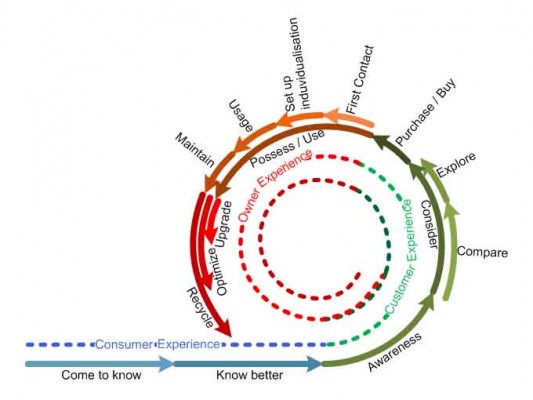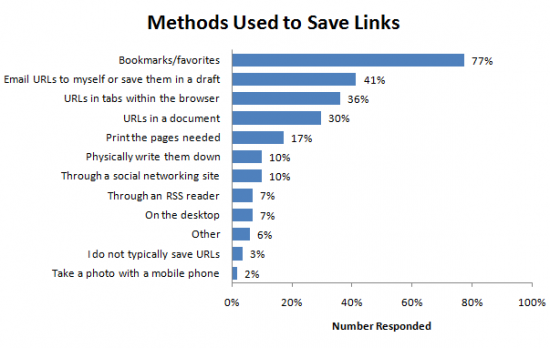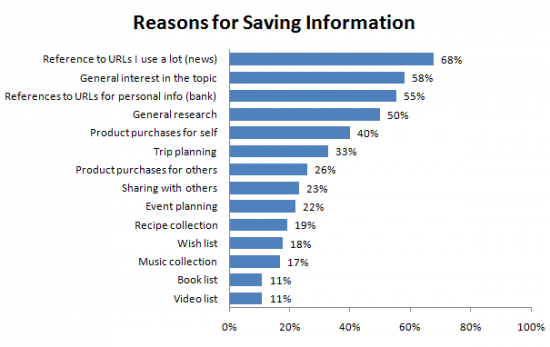
Źródło: Walk a while in someone else’s shoes: Exploring the Role of C…s, Holger Maassen
In user experience we trust

Źródło: Walk a while in someone else’s shoes: Exploring the Role of C…s, Holger Maassen
(…) when I compare a UI bug such as “The Help button is not in the usual location” to “The application crashes when I try to save”, it’s easy to see how a UI bug ends up with a low priority. In fact, I totally agree.
The problem is the scale that the bug tracking system uses. The bug priorities are all about the function of the software, not the usability of the software. In practice this means that having the application crash or fail to save data is considered a disaster – highest priority. But having the user give up and stop using the software isn’t on our scale.
The bug system scale measures whether or not the software functions – does it do what it’s supposed to without errors? And this is something that we can easily quantify. When there’s a problem we get a bug report, then the software engineers try to reproduce the bug and then track down the problematic code and fix it.
Since UI problems rarely cause anything resembling a crash, they end up in the “low priority” bucket nearly every time. (…)
And there’s absolutely no system for representing these problems in the bug system. Bugs are not evaluate in the aggregate – they’re looked at individually. No one will die from one cut, so each bug is unimportant. But taken together, they are a bigger problem.
Źródło Death by a Thousand Cuts, Two Rivers Flowing, Hagan Rivers
When conducting your next online survey or usability test, anticipate somewhere around 10% of the responses from online professional users to be disingenuous. If you’re hoping to have 100 usable responses for a study, plan on obtaining 110 and having to throw-out around 10.
Źródło: How many people cheat in online surveys?, Measuring Usability
- E-readers are not yet accepted as a replacement for a classic paper book.
- One of the primary reasons for this is poor usability.
- Another reason is that users expect more functions from an electronic reading device. This problem illustrates a challenge for future e-reader development; more functions should be integrated in such a way that they are usable intuitively.
- The legibility of the current e-reader generation is good; e-ink technology enables a reading process that is very similar to the reading process for classic paper books.
- For people with visual impairment, e-readers have the advantage of providing an opportunity to adjust the font size.
Kindle nie był badany.
Źródło:
– Improving the Usability of E-Book Readers – International Journal of Usability Studies (podsumowanie)
– Improving the Usability of E-Book Readers , Eva Siegenthaler, Pascal Wurtz, Rudolf Groner (pełen artykuł)
Expedia analysts realised the site needed to be changed after investigating why many customers who clicked the ‘Buy Now’ button on the company’s site did not complete the transaction.
“This is someone who was on our site, found the right location and hotel, put in all their billing and travel information and clicked the ‘Buy Now’ button,” Megibow said.
“As far as leading indicators of purchase intent go, this is as good as it gets and yet we weren’t taking the money.” Analysts began examining and correlating information about these failed transactions to identify what traits they had in common. The answer, it turns out, was quite simple: “We had an optional field on the site under ‘Name’, which was ‘Company’,” Megibow said.
“It confused some customers who filled out the ‘Company’ field with their bank name.” After putting in their bank name, these customers then went on to enter the address of their bank, rather than their home address, in the address field. “When it came to address verification to process the credit card, it failed because it was not the address of credit card holder,” Megibow said. ”
After we realised that we just went onto the site and deleted that field – overnight there was a step function [change], resulting in $12m of profit a year, simply by deleting a field.
“We have found 50 or 60 of these kinds of things by using analytics and paying attention to the customer.”
Źródło: Expedia on how one extra data field can cost $12m, Silicon.com.
Starmer: It’s interesting because pretty recently we’ve started in working with agile methodologies and a lot of user experience people I know want to run away from agile because, historically, it’s been a developer’s way of looking at the world. But we’ve been really successful thus far at figuring out the best ways to integrate user experience with agile approaches.
We do something that I’ve heard other people call “Sprint 0″—starting the user experience work early so that we can get some stories generated and user requirements from a user perspective generated early enough that developers have plenty to work on. So we’re really moving away, in a lot of cases—for the website at least—from a waterfall approach of writing up reams of requirements in advance.
Źródło Crafting the UX of REI’s Retail Experience | UX Magazine.
Za stroną (właśnie powstającego, więc w budowie) SIG HCI Polska:
Zapraszamy serdecznie na wykład dr Urszuli Strawińskiej “Psycholog w świecie technologii, czyli rzecz o myszach, ludziach i botach” odbywającego się w ramach comiesięcznych spotkań oddziału CHI Polska w dniu 14 grudnia o godzinie 18:00.
Miejsce wykładu: aula PJWSTK przy ul. Koszykowej 86 w Warszawie (mapa dojazdu)
Ula Strawińska jest psychologiem społecznym, absolwentką kierunku Społeczna Psychologia Informatyki i Komunikacji w SWPS. Zajmuje się osobowością z perspektywy dynamicznej psychologii społecznej, także prowadzeniem szkoleń z zakresu tzw. miękkich umiejętności psychologicznych oraz szkoleń technologicznych. Ukończyła studia doktoranckie na Uniwersytecie Warszawskim, w Instytucie Studiów Społecznych oraz na Florida Atlantic University (Boca Raton, Floryda, USA).
Najciekawsza część tej prezentacji zaczyna się od slajdu 38/39 – prezentacji wniosków.
Z listy kilkuset adresów i feedów RSS, będących źródłem do informacji do tego serwisu Software Usability Research Laboratory działające na Unwiwersytecie stanowym Witchita pełni bardzo szczególną rolę. Ich newsletter (Polecam jego prenumeratę! Warto!) zwykle dotyka fascynujących i słabo przebadanych aspektów codziennej interakcji ludzi z komputerami. Nie inaczej jest z jednym z ostatnich opublikowanych przez nich badań (zebranych na podstawie ankiet na przełomie roku 2009/2010), dotykających banalnej kwestii “zachowywania informacji z Internetu”.
The majority of respondents (55%) reported using 2-3 methods of saving information. The most common way to save information was through Bookmarks or Favorites, followed by e-mailing links to themselves, saving URLs in tabs within the browser, and saving URLs in a document. Seventeen percent reported that they print the pages of interest as a method of saving. Taking photos with a mobile phone, other means of saving not listed in the survey, and saving to the desktop were the less common methods given as a way to save links. Only 3% of the respondents indicated they do not typically save URLs.

Bookmarking methods used to save links - Źródło: http://www.surl.org/usabilitynews/122/saving.asp
When asked why they save information, the most frequently cited reasons were related to helping them work more efficiently, such as references to links that they use frequently, references to personal information, or simply general interest in the topic. The least frequent reasons included saving information for music/video/book lists, recipes, event planning, or for sharing the information later with others.

Reason for Saving Information - Źródło: http://www.surl.org/usabilitynews/122/saving.asp
Źródło: Creatures of Habit or Convenience? Users Still Use Browser Bookmarks and Email to Save Information, J. Owens, A. D. Shaikh, & B. Chaparro, Software Usability Research Laboratory, Wichita State University
Wzbudzający dyskusje program certyfikacyjny/projekt “Użyteczna strona” na 3 grudnia 2010 roku, zaplanował konferencję “Dzień Użyteczności”. Głównym gościem spotkania jest Robert Hoekman, autor ksiązek: Desigining the Obvious i Magia interfejsu, który poprowadzi dwuczęściowy wykład.
Ponadto Andrzej Sienkiewicz wystąpi z prelekcją “O czym nie powiedzą Ci konsultanci od usability?” – jak zrozumieć rzeczywiste potrzeby klienta i wspomóc go narzędziami użyteczności?
W trakcie spotkania odbiędzie się również galą Laureatów programu Użyteczna Strona, czyli firm “które potwierdziły użyteczność własnych serwisów internetowych”. Pełna agenda spotkania dostępna jest na stronie konferencji.
Miejsce spotkania:
Hotel Mercure GRAND
Warszawa, ul. Krucza 28 (zobacz na Google Maps)
Od kilku dni są już dostępne materiały ze spotkania World Usability Day, które miało miejsce 4 listopada we Wrocławiu. Prezentacje dostępne są na Slideshare pod tagiem WUD2010, a na stronie konferencji mozna obejrzeć również relacje wideo.
Copyright © 2010 - 2024 Tomasz Skórski · Autor na Google+
Recent Comments